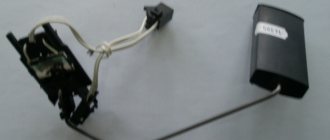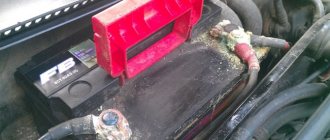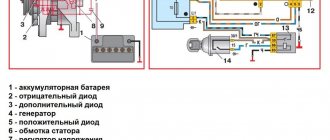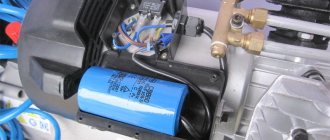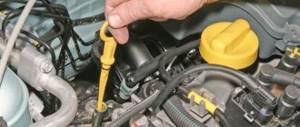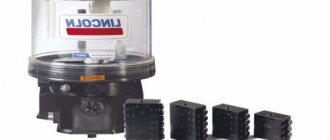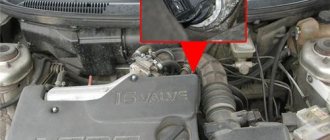Probably many people have had to face the question: why doesn’t the fuel level sensor work?
And the following situation also happens: after starting the engine, the sensor shows that the tank is empty, and while driving, the value on the sensor reaches the desired level. The following option is also possible: the needle is stuck at zero, but in fact there is still half a tank or the values on the dashboard are constantly changing. It can be very difficult without a sensor working properly, especially on long trips. You need to constantly keep in mind the moment of the last refueling and its volume, and keep a canister of fuel in the trunk just in case.
Due to the mass of inconveniences caused by one sensor, we will look into the problem in this article.
Electronic fuel level indicator
The fuel gauge sensor is one of the main control elements of a car. With its help, the motorist receives information, which is displayed on the front instrument panel, about the availability of the tank. This mechanism is based on a resistor with a moving contact (extreme resistance values are 50-300 Ohms), which changes its state during the oscillation of the float:
- If the amount of gasoline changes, the float moves and changes the resistance of the resistor;
- As soon as the fuel volume reaches the smallest figure, the contact closes, and it notifies the driver about this. Typically the signal is output to a digital fuel level sensor . The light comes on when there are 5-6 liters left in the container. fuel.
Fuel level sensor resistor
If you notice that the device displays incorrect information or does not react at all to changing the amount of gasoline, you need to dismantle it, check its condition, and if faults are found in the system, replace it with a new one.
In Soviet-made vehicles, the control device is located directly in the tank. In order to save space, it is installed together with the fuel pump. Therefore, if you need to change the FLS (fuel level sensor), you will also have to remove the fuel intake. First of all, to gain access to the device, you need to remove the rear seat and remove the special hatch.
Fuel level sensor assembly with fuel pump
What does error P2067 mean?
Trouble code P2067 is a general trouble code that indicates that the Engine Control Module (ECM) has detected that the fuel level sensor “B” circuit voltage is too low (compared to the manufacturer's specification). Fuel level sensors are used to determine the amount of fuel in the fuel tank and are typically installed in the fuel tank or built into the fuel pump assembly. Most modern cars have two fuel level sensors (“A” and “B”), one on each side of the fuel tank.
The fuel level sensor transmits information regarding the fuel level in the fuel tank to the vehicle's ECM in the form of a voltage signal. The lower the fuel level, the lower the voltage. If the vehicle's ECM detects that the fuel level sensor "B" circuit is too low, it will store the P2067 error code and the Check Engine light will illuminate on the vehicle's instrument panel to indicate a malfunction.
Checking and repairing the fuel level sensor VAZ 2106
Before getting rid of the old device and replacing it with a new one, you should make sure that it is really out of order. This can be done in several ways:
- If the receiver distorts the readings, you can simply adjust it. First, connect it and manually change the position of the lever. At the same time, keep an eye on the gasoline gauge. In working condition, it will move according to the float. If it is located below, the arrow will point to “0”, and from above – to “1”. If the arrow shows incorrect parameters in one position or another, try bending the adjustment tab on either side. This will cause the float to drop even lower or higher. Such fuel level sensor repair will allow you to adjust the readings most accurately.
Adjusting and repairing the fuel level sensor - Adjust the FLS directly on the front instrument panel. To do this, you just need to turn off the ignition and disassemble it. Next, remove the arrow and connect the device to the system. After a couple of minutes have passed, you can change the position of the float up (as if the container is full) and at the same time set the arrow. Then make sure it shows the correct information at different float positions.
Adjusting the fuel sensor on the dashboard - If the arrow indicates that the gas tank is full when in fact this is not the case, follow these steps:
- We check the serviceability of the wiring at the back of the front instrument panel. Before doing this, remove the device and tighten the nuts attached to the indicators and ensure contact.
- Pay attention to the components located under the handbrake of the car. Often, it is in their malfunctions that the failure of the FLS lies.
- It happens that all the mechanisms, including the gasoline meter, are working properly, but the arrow still does not correctly display the degree of fullness of the fuel tank. This happens if an older model of control device is installed. Such a device cannot be restored - it must be replaced.
- If the reason is that the arrow is off, you should press the daily mileage button and turn on the ignition.
- Another cause of failures in the unstable functioning of the fuel volume regulator can be oxidation of the contact plates.
The fuel level sensor is lying
The fuel level indicator can either underestimate or overestimate the practical values of the amount of fuel. With such symptoms, adjusting the sensor may help.
There are two types of adjustment for this type of malfunction.
- First:
move the float pin to two extreme positions, while the arrow on the indicator should also fall into the two extreme positions 0 (empty) and 1 (full). If in the extreme position of the pin the arrow does not set to “0” or “1”, then it is necessary to bend the pin so that it remains movable and adjust with the bent axis; - Second method:
disassemble the instrument panel and get to the fuel level sensor itself, remove the arrow from it and reconnect the wires to the sensor. Start the car and let it sit for about 10 minutes. Then set the pointer axis to the extreme position “1” and connect the pointer.
Checking the FLS on Lanos - how to check the sensor for serviceability
After replacing the fuel level sensor, there may be no readings on the dashboard. This is due to the fact that the cause of the malfunction is not the sensor. So that after replacing the FLS you do not have to continue troubleshooting, it is recommended to check the part for serviceability. Few people think about checking the FLS for serviceability, and even more so, almost no one knows how to check the part for suitability. But it is quite possible to do this, and for this you will need a multimeter. The verification process consists of the following steps:
- First you need to remove the ignition module from the gas tank on which the FLS is located
- We connect the probes of the device set to resistance measurement mode to the FLS contacts.
- When changing the position of the slider, the resistance value of the device should change. If the resistance does not change, it means the FLS is faulty and must be replaced. Sometimes, to eliminate a malfunction, it is enough to replace the slider connected to the float
- If the resistance changes, then you need to know the following: in the float position, when the tank is empty, it should increase, and when the tank is full, it should decrease. The maximum resistance on the sensor when the tank is empty is 284 Ohms (120 Ohms), and when the tank is full its value corresponds to 38 Ohms
Having confirmed that the FLS on Lanos is faulty, you can begin to replace it. A detailed description of the replacement process is described above. As you can see, identifying and eliminating a malfunction in the form of a non-working fuel quantity indicator in the tank is not at all difficult.
Possible malfunctions and ways to eliminate them
Despite the simplicity of the design, sometimes problems arise with FLS. If the device malfunctions, the gasoline sensor does not show the fuel level correctly, the analog gauge needle either does not rise or shows a full tank, etc. If the FLS is lying, then electrical and mechanical problems are possible.
Electrical problems are caused by:
- oxidized contacts,
- blown fuse,
- wiring damage.
Repairing the fuel level sensor in this case consists of cleaning the contacts, replacing the fuse, checking the electrical network and replacing damaged areas. The cause of mechanical breakdowns is most often wear and violation of operating rules.
There are several reasons:
- failure of the float seal,
- wear of components,
- lever bend.
The FLS gives incorrect readings when the sectors are worn out. They quickly become unusable due to the constant movement of the runner over them. If the wear is small, then to restore functionality you can bend the slider; it will again be in contact with the surface of the sector. If the wear is significant, the fuel level sensor will need to be replaced (video author Pavel Cherepnin).
The lever can be bent when the fuel sensor was carelessly removed from the tank or installed incorrectly. The consequence of this will be incorrect readings. If the float is broken, fuel will get inside and the float will not float on the surface. Naturally, the instruments will display incorrect information. Mechanical faults are eliminated by replacing parts or the entire device that determines the fuel level in the tank.
Incorrect readings may be due to incorrect placement of the float limiter or an unadjusted fuel level sensor in the tank. There is a way to fool the fuel level sensor. To do this, you need to adjust the angle on the rod that holds the float. By changing the angle, you can make the regulator show more accurate data.
Inaccurate indicator readings can be deceived by adjusting the angle on the rod holding the float. By bending it in different directions you can ultimately achieve more accurate readings.
When to make adjustments
The first calibration of the gas level indicator is carried out at the time of installation of gas equipment on the car. But over time, the indication on the button may become confused or may not be initially configured correctly. Thus, if the arrow on the gas cylinder shows one value, and the indication on the button is completely different, you cannot do without adjusting the gas level sensor.
You can entrust the procedure to professionals, but why pay a lot of money for something that you can do yourself?
First of all, you should understand whether the gas level indicator showed the correct value before? If not, then it will take a little more time and a special HBO cable to connect the electronic control unit to the laptop and set the correct value for the gas level sensor.
For each sensor in the control unit, you must set its own value. You should also know what kind of sensor is installed in your system and according to what scheme it works - it measures resistance or measures voltage. Having set the necessary sensor parameters, you should proceed to the calibration itself.
Why do you need an FLS on Lanos?
The Lanos fuel level sensor is designed to determine the amount of fuel level in the tank. This element is associated with a pointer on the instrument panel. The pointer is a scale with an arrow. The relationship of the sensor with the control unit allows the driver to control the amount of fuel in the gas tank.
If on cars with carburetor engines the fuel indication sensor is intended solely to prevent the possibility of sudden emptying of the tank, then on injection cars this element also serves other purposes. A more important purpose of the FLS on fuel-injected cars is to determine the amount of fuel in the tank in order to prevent the fuel pump from idling. It is strictly contraindicated to allow the gas pump to operate without pumping fuel, as this leads to a reduction in its service life.
This is interesting!
To prevent premature wear of the fuel pump on Lanos, Sens and Chance cars, it is necessary to eliminate the possibility of operating the vehicle with an amount of fuel less than 0.5 tank.
When the fuel in the tank runs out, the engine cannot operate. It is strictly contraindicated to completely empty the gas tank on fuel-injected cars, otherwise the risk of having to replace the gas pump on a Lanos increases.
